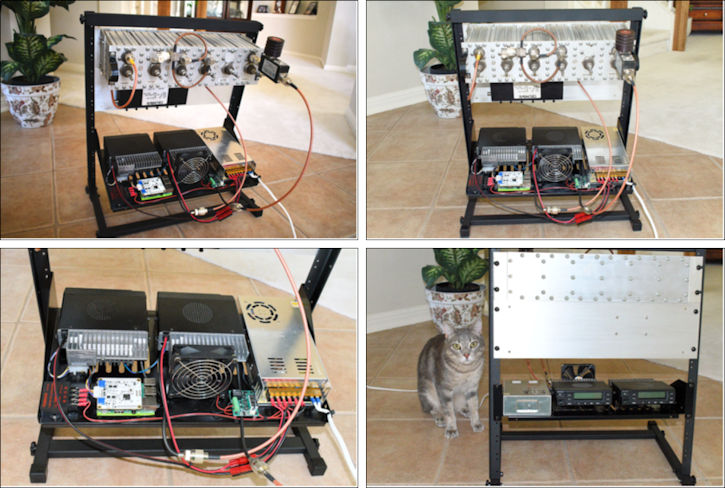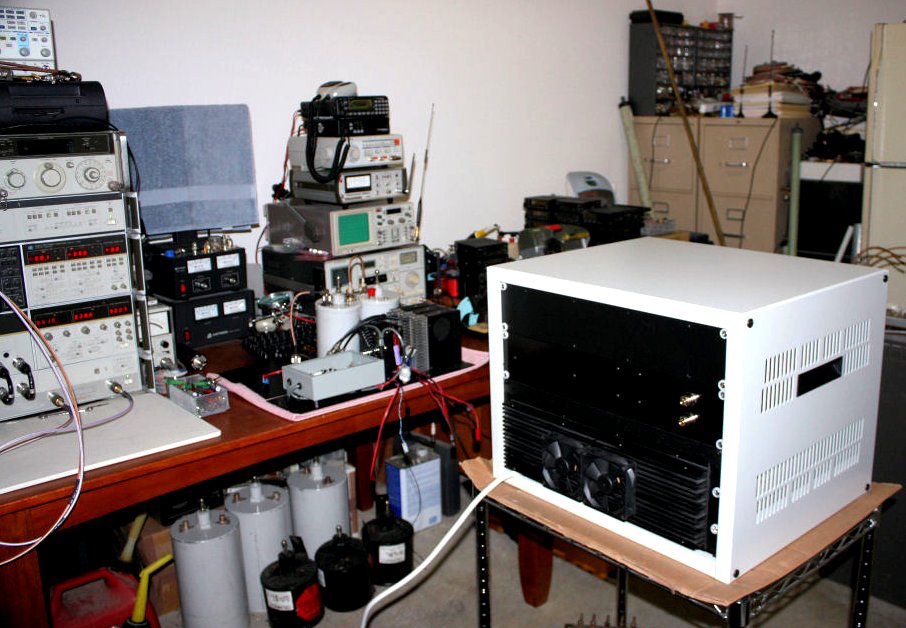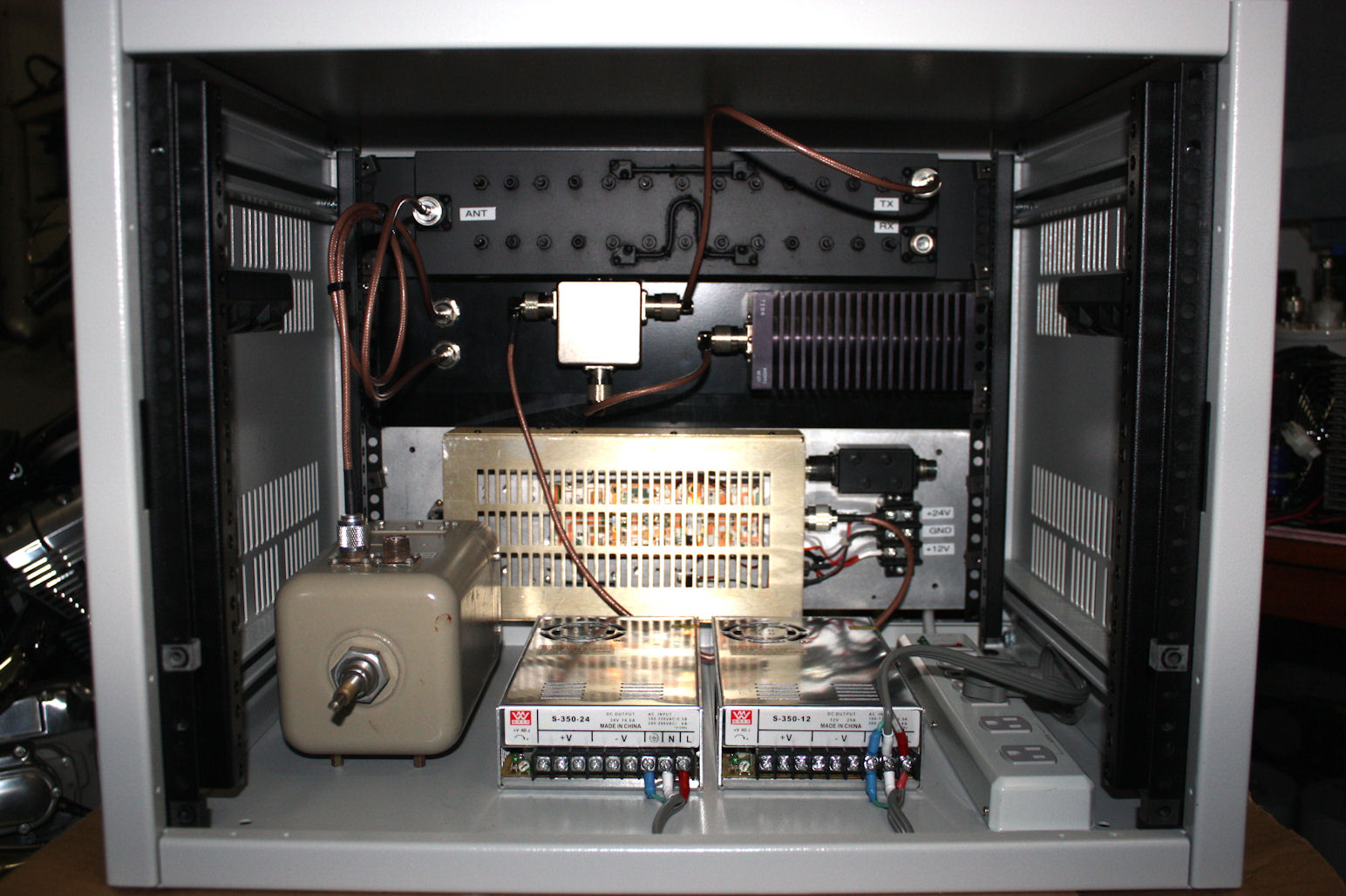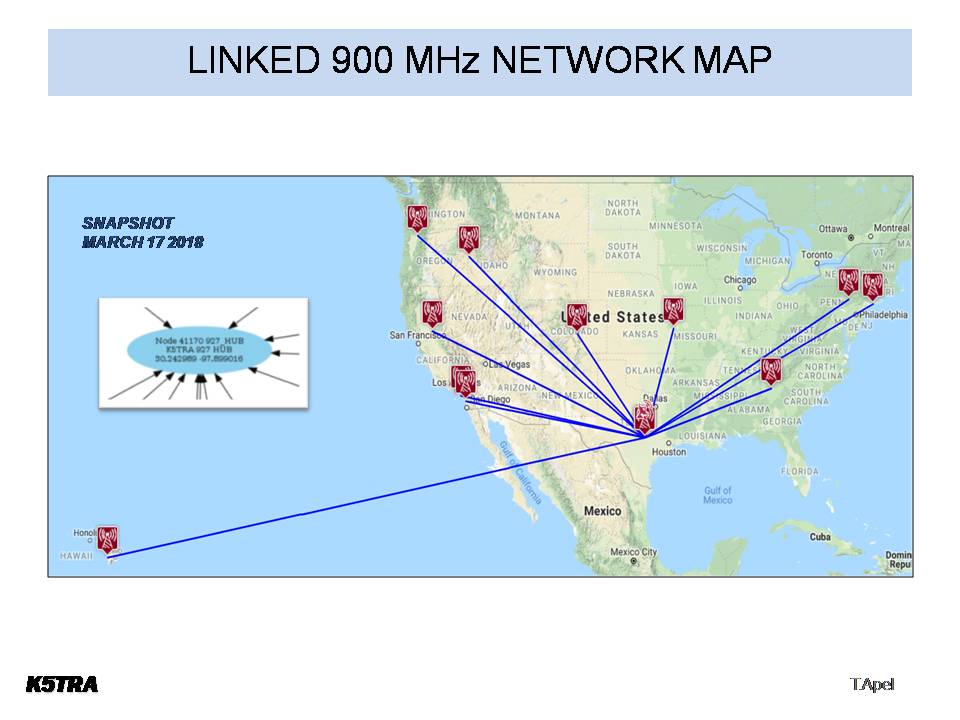
900 MHz P25 REPEATER (with TK-981 radios)

K5TRA 927 MHz repeater construction & testing

927 MHz repeater panels: TR/RX & link radios, controller, LNA/preselector cavities, & fuse block

Interior of 927 MHz repeater with duplexer, circulator, PA, powersupplies, and link cavity
K5TRA Repeater Construction
The transmit and receive radios I have used are Kenwood. The earlier repeaters use a pair of TK-931s, and are stil in service in the Portland and Vancouver metro area. All four repeaters in the greater Austin metro area use TK-941s. My portable repeater also uses a pair of TK-941s. Link radios in the earlier repeaters (Portland/Vancouver) are Motorola Maxtrac and CM-200. The TK-840 is used to link all of the Austin machines.
My early 900 MHz repeaters used modified Motorola cellular power amplifiers. The Motorola cellular 300W (SGTF-1019) PAs were used in the Portland repeaters, and the 150W (SGTF-2520) in the early Austin repeaters. Fans are used on all PAs and on transmit radios. These amplifiers are rated in PEP due to original operation in linear service. Hams have used them for SSB operation too. In FM service, they perform very well. Modifications are not difficult. The bias & control board can be removed and replaced with a LM-7805 +5 V regulator. +24 V is required for collector supply. If the STGF-1019 PA is used, the integrated isolator on each amplifier strip must be bypassed (top frequency for the isolator is 904 MHz). This can be accomplished by either an RG-316 jumper around the isolator, or by removing the puck from the housing and running the jumper through the empty circulator shell. If the SGTF-2520 is used, the isolator is separately mounted in the housing. It can simply be removed. Biasing is the same as with the higher power amplifier.
Since 2013, my preferred power amplifiers for 900 MHz repeaters have been MASTR-III variants. There are two families of these PAs: (1) the GE-Ericsson that have a very heavy cast Aluminum heat-sink and housing, and (2) the M/A-com Harris that have an extruded Aluminum heat-sink with a large fan. The heavy GE-Ericsson PA has a pushpull BJT final and an internal isolator. The M/A-com Harris PA has a pair of LDMOS finals that are quadrature combined and an internal isolator. Both these MASTR-III PAs are very reliable apower amplifiers capable of >100W. I typically set them to run around 75W.
Two power supplies are used in all repeaters: +12V and +24V. My prefered power supply is from the Meanwell 350W series of switching type supplies. Fuse blocks are used to provide fuses on all lines. A dedicated AC power distribution strip is mounted in the cabinet.
Celwave isolators with 100W loads are placed between PA output and duplexer TX input. This is not only for PA protection to mismatch; but for IMD protection (PA final can mix repeater output with other co-located signals).
A LNA with a pre-selector filter is placed between the duplexer port and the receiver input. I have used ARR, Angle Linear, and Minicircuits LNAs. My preference is either Chip Angle's product or the Minicircuits pHEMT product: ZX60-0916LN. A pair (P-PR) of WACOM cavities is my pre-selector preference.
I have used many different types of duplexers. The easiest to get with good performance are the WACOM cavities. That said, I really like the performance offered by dual-combline cellular duplexers. Narda West (Loral) dual-combline duplexers are in all of the Austin 100W repeaters. There are two different types of these. One can be used without modification, the other requires shortening the resonator rods. One of the Austin machines uses a duplexer of this type, while the other two high power Austin repeaters use Narda duplexers that do not require modification. More information about this modification can be found in the files section at the bottom of this page. Steve-WB7BYV and Greg-WB6ZSU have both performed this modification with good results. Greg-KJ6KO also uses Narda West duplexers in NC9RS system.
Link radios all have dedicated Motorola T-1500 (PR) cavities to protect against IMD in both transmitter and receiver circuits from co-located sources.
ICS Linker-IIa controllers were used in the two original Portland repeaters, the four Austin repeaters and in the portable repeater. There certainly are more feature rich controllers available. I use an Arcom RC-210 in my UHF repeater. Given the quantity multiplier, a low cost 2-port controller with full basic features was my solution. (I wasn't looking for a controller to talk to me). The Linker-IIa has worked out well for me. I use it's fan control to also key biasing to the PA. Additionally, I have made a couple of mods such as inhibit PL in the link transmitter during ID, and reduction of tone amplitude range. Please contact me for more info about this. I also use a DTMF controlled relay to toggle power to the controller as a failsafe means of hard rebooting. This can be invaluable in a mountaintop installation in the middle of the winter.
In 2011, I began migratng the 900 MHz network internet linking from EchoLink to Allstar. The *927_TECH* conference server is still maintained and linked into the Allstar 900 MHz network; but, the EchoLink side has become secondary. Allstar is an implementation of asterisk, an open source PBX that runs on Linux. The Linux platform can provide complete multiport repeater controller functionality, thereby eliminating the need for a controller board! The most recent repeaters that I have built do not have hardware controller boards in them. Initially, in 2013, I was building Allstarlink repeaters with with mini-ITX Celeron boards. The results with the mini-ITX builds was very good. Allstar has a range of codecs available (depending on available BW). Linked and repeated audio is superb. Next, ARM processor boards began providing a platform for Allstarlink repeaters. The first of these was the "Beaglebone Black" boards. Results were so good with BBB boards that it was safe to say that ARM processor boards were the future direction for all new builds. By 2015, the Raspberry Pi boards began replacing the Beaglebone Black boards as the prefered platform. This was initially with the RPi 2, followed by the RPi 3 and 4 variants. I have added an Allstar page that may also be of interest: http://k5tra.net/AllstarLink.html . If I can help with information, please feel free to contact me.

Click for current connections
Allstar 41170 -- This is our primary 900 MHz linking HUB
Additional linking is available with the *927_TECH* EchoLink conference server (linked to Allstrar 41170).

*927 TECH* EchoLink reflector
While the majority of linking on our 900 MHz repeater network is now via Allstarlink, we still maintain the *927_TECH* EchoLink conference server as a dedicated linking reflector. This is a private conference with a "white-list" (900 MHz group only) for connection. If you have a 927 MHz repeater or link station and would like to get linked in, please contact K5TRA - tom@k5tra.net.
927 MHz P25 REPEATER
I used a pair of TK-981 transcrivers to build a 900 MHz P25 repeater. The TK-981 receiver radio requires several mods. The front-end ceramic filters must be replaced for good sensitivity on 902 MHz. Many TK-981 radios will not receive on 902 MHz because the VCO will not oscillate for frequencies that low. I modify the VCO for repeater receivers by changing 3 surface mount capacitors inside the VCO module. That modification is detailed in the PDF link below. The baseband audio lines must be DC blocked and appropriately padded. The receive pick-off is the standard DEO, discriminator audio. The transmit audio is injected after the DI point in the chain. It was also necessary to set both TX and RX audio as inverted. A Sinclair duplexer, Motorola RX filter and DB-589 were used. Several photos can be seen below:.

FM on 900 MHz is fun. The culture is very much like 70cm was 45 or 50 years ago. Radios are commercial, primarily Motorola and Kenwood. In 1970, it was Motorola, GE, and RCA. Chatter is usually interesting with some technical content. Activity level is good due to linking with other 900 MHz systems via the *927_TECH* linking reflector. For more info about radios and repeaters, download the "927 MHz presentation" file. Currently, there are more than 400 repeaters in the US on 33cm.